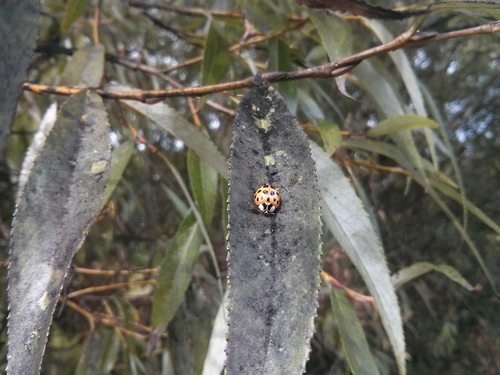Beware the Harlequin

The Harlequin ladybird (Harmonia axyridis), the world's most invasive ladybird, has been detected establishing in Auckland. The biosecurity staff of the Ministry for Primary Industries having been work hard to figure out how far it's already spread. Unfortunately, it's sounding like it's already beyond eradication. That would be bad news for NZ ladybirds as the Harlequin ladybird, an Asian native species, has reached high densities in Europe and North America and displaced their native ladybirds.
We urgently need all sightings of Harlequin ladybirds, and also all other ladybirds so we can assess whether the Harlequin out-competes out native ladybirds like it's done overseas. We've set up a project to do just that: NZ Ladybird Watch. Please join us in recording all the ladybirds we can find.
The Ministry for Primary Industries has produced a useful fact sheet on the Harlequin ladybird and its identification.
It can be confused with the similar looking Harmonia conformis ladybird. Here's what Auckland entomologist Stephen Thorpe (@stephen_thorpe) tells us about how to ID the Harlequin ladybird, Harmonia axyridis: "It is a very variable species (how variable in NZ, I don't know). It is conspicuously larger than the other Harmonia species in NZ. The pronotum is (usually) white, with a symmetrical median black pattern. The larvae have 4 yellow papillae forming a square on the abdomen." If in doubt, just post a photo here and entomologists like Stephen will help with the ID.
You can see all of the NatureWatch NZ observations of Harlequin ladybirds here. Below is a selection to help you know what to look out for.

A Harlequin ladybird in Auckland on 9 April 2016 observed by @jacqui4.
A Harlequin ladybird in Auckland on 19 May 2016 observed by @stephen_thorpe.
Another colour morph of Harlequin ladybird, found in Auckland on 22 May 2016 observed by @stephen_thorpe.
A pupa of Harlequin ladybird, found in Auckland on 22 May 2016 observed by @stephen_thorpe.
A larva of Harlequin ladybird, found in Auckland on 15 May 2016 observed by @stephen_thorpe.









